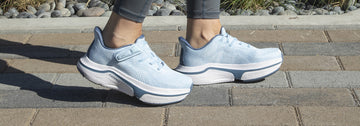Parkinson’s disease (PD) is characterized by difficulties with walking and other common movements. Given the symptoms of this disease, it is no surprise that patients with PD develop what is known as “Parkinson’s gait.”
This guide to gait training exercises will explain more about what causes Parkinson’s gait, the symptoms that typify it, and what you can do to improve your gait if you have PD.
Parkinson’s gait is a particular gait that is common among patients with Parkinson’s disease.
According to Parkinson’s Europe, features of the Parkinson’s gait include bradykinesia (slowed movements), a shorter stride, dragging, shuffling steps, a stooped posture with a lowered head and shoulders, a reduction in arm swing, stepping using the front parts of the feet, and bending at the knees and hips.
Not every patient with PD will exhibit all of these signs and symptoms. The gait may include all of these features, or just some of them. People with PD also may have a hard time initiating movements, or may freeze in the middle of walking. Turning can be challenging as well.
Walking with an unnatural gait combined with difficulties controlling motor functions can impact balance in people with PD.
Difficulties with balance in PD are both prevalent and debilitating. In fact, the Parkinson’s Foundation calls it the “most challenging of the major Parkinson’s disease (PD) movement symptoms.”
In a study that monitored patients with PD over a 6-month period, falls were recorded by 59%. Falling increases the chances of injuries.
As Parkinson’s disease is most commonly diagnosed in older patients, it can be one of the causes of elderly parents falling.
Over half of people with PD have a hard time turning. As with loss of balance, difficulties turning can cause patients with this disease to fall, sometimes sustaining injuries.
To decrease the likelihood of falling from Parkinson’s gait, you should try to retrain your gait. An effective way you can do that is through regular, appropriate gait training exercises wearing the right shoes.
1. Walking or running
Walking is one of the most basic exercises, doing the very activity you are working on improving. While you are walking (or running), be as mindful of your movements as you can. It is common for patients with PD to walk on the front parts of their feet; remind yourself to plant your heels before your toes.
Studies show that exercises like running may reduce mortality rates in PD patients.
2. Cycling
According to this research, riding a bicycle is a good way to improve your Parkinson’s walk, motor performance, and quality of life.
3. Dance
Dancing is another form of exercise that offers multiple benefits to people with PD. You can improve your balance, gait and quality of life by dancing.
4. Non-contact martial arts
Martial arts and related disciplines such as tai chi and qi gong can lead to improvements in areas like balance and coordination, which in turn may assist with establishing a more natural gait and preventing falls.
5. Yoga
According to a study in Behavioural Neurology, if you practice yoga with PD, you may improve your mobility, motor function and balance. Yoga can also help reduce anxiety and depression in people with PD.
6. Pilates
This study found that pilates may be more effective than “other conventional exercises” at improving lower body function in patients with PD.
7. Strength training
This review indicates that strength training can enhance physical parameters while also improving overall quality of life for patients with Parkinson’s disease.
8. Non-contact boxing
An effective workout that is recommended widely to patients with PD is non-contact boxing. This is a type of exercise that uses boxing moves, but does not involve fighting against an opponent. Practicing non-contact boxing can help improve your balance. It can also boost eye-hand coordination and confer other physical benefits as well.
Choosing footwear that is suitable for walking with Parkinson’s can make a big difference for your gait training exercises.
Shoes that are poorly designed can increase your fatigue as you walk, increase issues with your Parkinson’s walk, and make it more likely you will fall.
Well-designed shoes, on the other hand, can stabilize your feet, help you move more naturally, and reduce your chances of falling and getting injured.
It is important to know that in Parkinson’s, the feet and ankles may sometimes swell. The chances of experiencing swelling increase if you are sedentary or you have slowed movements.
So, when you are selecting shoes for Parkinson’s, you will need to choose footwear that will be loose enough to accommodate your swelling, but snug enough to provide adequate support and stay on your feet.
In some cases, it may be easiest to purchase shoes in a couple of sizes. That way, you have the ideal size for when your feet are swelling and for when they are not.
As we discussed earlier, a gait where the toes drag along the ground or strike the ground before the heels can be common with Parkinson’s.
This Parkinson’s walk gait feature can make it challenging to safely clear obstacles, making it easy to trip and fall.
Thankfully, there are adaptive shoes on the market developed by specialists that can help you overcome this issue.
The Cadense Original Adaptive Shoes for men and women with patented variable friction technology adapt as you walk to uneven surfaces. That way, you can “glide” across obstacles, even if your gait does not allow you to fully lift your feet and drop your heels before your toes.
Once you have shoes that help you move easily and maintain your balance, you will find it easier to do exercises such as walking or running. You can then leverage the benefits of those exercises for improving your gait and maintaining your physical and psychological wellness.
As your gait improves and appropriate footwear helps you remain stable and upright, you also will be able to enjoy increased independence in your everyday life. Your mobility will be enhanced, and you will be able to do more everyday activities unassisted.
If you are ready to find shoes that help you walk comfortably and effectively, explore the full Cadense collection of shoes for Parkinson’s disease.








![[color: black] Original Men's Adaptive Shoe](http://cadense.com/cdn/shop/files/Mens-BLK-T1-LG.jpg?crop=center&height=300&v=1765338442&width=300)
![[color: white] Original Women's Adaptive Shoe](http://cadense.com/cdn/shop/files/Womens-WHT-T1-LG.jpg?crop=center&height=300&v=1765381322&width=300)





